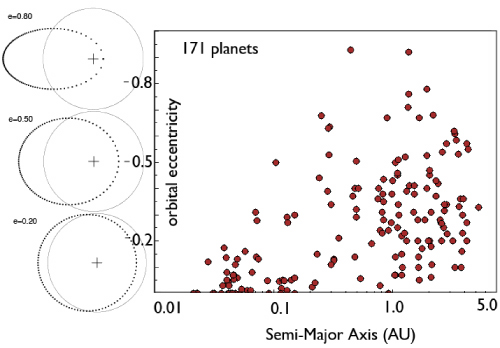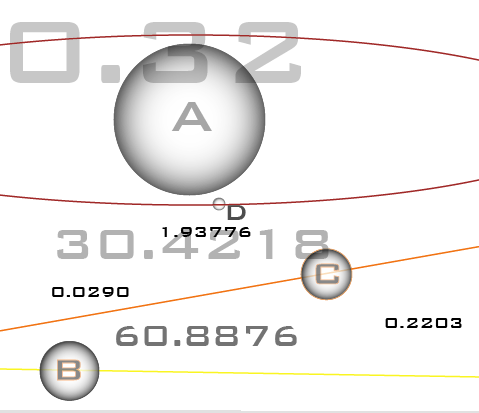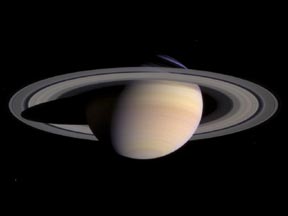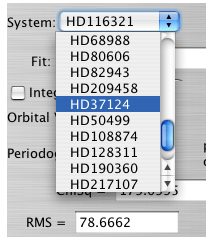55 Cancri is an ordinary nearby star, barely visible to the naked eye. Through a modest telescope (or, more practically, with the use of the Goddard Skyview) one sees that it is actually a binary pair.
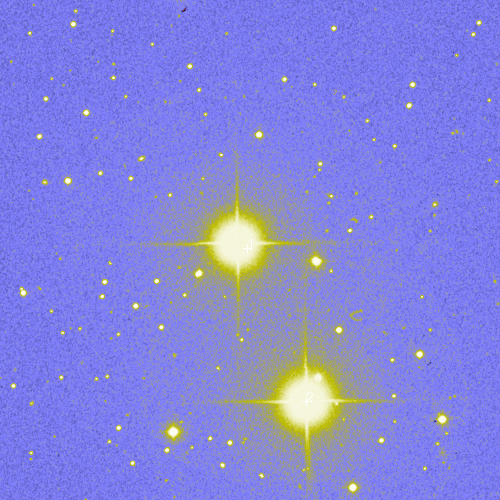
55 Cancri “A” (the bright star in the middle of the above photo) harbors an extraordinary planetary system. Indeed, it was the subtlety and the depth of the 55 Cancri radial velocity data set that motivated us to develop the systemic console. The fact that the 55 Cancri system continues to defy easy categorization gives us confidence that the systemic collaboration will be a worthwhile project.
Where to begin?
Click on the system menu on the console, scroll down, and select 55 Cancri. (If you’re unfamiliar with the console, and if you’re the methodical type, there are three tutorials available on the menu bar to the right. Otherwise, just follow along!) The published radial data for 55 Cancri now appears in the main console window. The sweeping spray of points, with its curiously non-uniform distribution, contains a fascinating narrative in its own right.
The very first point in the data set has a timestamp of JD 2447578.73 A Julian Date Converter tells us that this was 9:31 PM on Monday Feb. 20, 1989 (Pacific Standard Time). The observation was obtained by Geoff Marcy at the Shane 3-meter telescope at Lick Observatory on Mt. Hamilton, and the velocity error is 9.7 m/s. Back in 1989, Geoff and his colleague Paul Butler were laboring to improve their iodine cell technique, and were struggling to get enough telescope time to adequately track the motion of about 70 nearby solar type stars with the eventual hope of detecting giant planets.
The first 10 radial velocity points were obtained at a rate of 1 to 3 per year. With hindsight, it is easy to see that these 10 points are ample cause for a planet-hunter to be optimistic. The radial velocity variation in the first 10 points spans more than 100 meters per second, suggesting a signal with a signal-to-noise of at least five. The periodogram of these ten points shows a strong peak at 14.65 days, indicating that the data could be explained by a planet with 80% of Jupiter’s mass, circling on an orbit lasting just over two weeks.
Today, if such a planet were discovered, the announcement would not make the news, and the major excitement would be among amateur transit hunters, who would likely have a new high-priority follow-up candidate with a ~5% transit probability. (A two-week period is right at the borderline where transits can be reliably confirmed or ruled out by the photometric collaborators working with the RV-discovery teams prior to announcement of the planet).
In 1993, however, nobody was expecting to find Jovian planets in 14-day orbits. Conventional wisdom at the time was informed by the architecture of our own solar system, and held that gas giant planets should be found beyond the so-called snowline (located at r=4-5 AU) of the protostellar disk. Although the theory of orbital migration had been studied in considerable detail, nobody had proposed that giant planets might regularly spiral in and then be marooned on very short-period orbits. I don’t know whether Geoff and Paul even considered the possibility that the 14.65 day peak in their data was real. If they saw the peak, it is more likely that they would have ascribed it to an alias, an artifact of their uneven hard-won sampling.
During 1994, the velocities suddenly started to trend upward. This would have seemed rather disconcerting, and may even have raised alarm. Was some unaccounted-for instrumental or astrophysical process affecting the newer radial velocity data? Certainly, at the end of 1994, the case for a planet orbiting 55 Cancri would have been weaker than it had been a year earlier.
Nevertheless, the 55 Cancri campaign was at an important turning point. The last measurement of 1994 (JD 2449793.80) has a remarkably lower error (3.3 m/s) than any of the earlier radial velocities. In November of 1994, the Schmidt camera optics on the “Hamilton” spectograph at Lick Observatory had been upgraded, and the resulting improvement effectively tripled the intrinsic resolution to which the spectral lines could be discerned. With the ability to measure radial velocities to a precision of 3 m/s, the planet search had suddenly entered an entirely new realm. When one is in the business of detecting Jupiters, a velocity measurement with 3 m/s precision is literally 10 times as valuable as a velocity with 10 m/s precision.
In October 1995, Mayor and Queloz announced their discovery of a Jupiter-like planet in a 4.5 day orbit around the nearby star 51 Peg. Due to a catalog error that misclassified 51 Peg as a subgiant, it had not been included in Geoff and Paul’s survey, but they were able to rapidly confirm the Swiss discovery.
All at once, the idea of a gas giant with a 2-week orbit was no longer outlandish at all. The telescopes on Mt. Hamilton, which had been slipping inexorably in worldwide prestige as larger telescopes were built on higher mountains, were suddenly at the forefront of relevance. The Lick 3-meter telescope-iodine-cell-spectrograph combination was the best instrument in the world for obtaining precision doppler velocities of bright stars such as 55 Cancri. Extrasolar planets were front page news. Alotments of telescope time increased dramatically. In the six months running from December 1995 through May 1996, 55 Cancri was observed 41 times at Lick. This drastic increase in the cadence of observations is easily visible in the radial data:
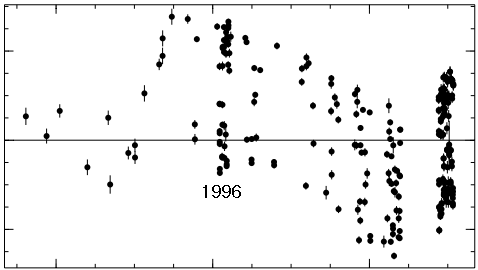
With the 41 high-quality observations, the presence of the 14.65 day planet was obvious in the power spectrum.
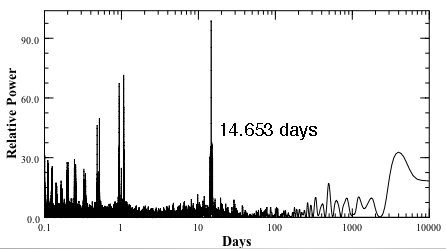
In October 1996, Paul, Geoff, and several other collaborators announced the discovery of the 14.65 day planet, and in January 1997, they published the discovery in a now classic paper that also introduced the world to the inner planetary companions of Tau Bootes and Upsilon Andromedae.
With eight years of data, it was clear that other bodies were present in the system. In the discovery paper, Butler et al. wrote:
The residuals exhibit a long-term trend, starting at -80 m/s in 1989 and climbing to +10 m s-1 by 1994 (the velocity zero point is arbitrary). The velocities appeared to decline toward 0 m s/1 during the past year, although at least another year of data will be required for confirmation. This trend and the possible curvature in the velocity residuals are consistent with a second companion orbiting HR 3522 [aka 55 Cancri] with a period P > 8 yr and M sin i > 5MJUP.
This speculation proved to be correct. Use the console to get a best-fit for the 14.65 day planet, and compute the periodogram of the residuals to the fit:
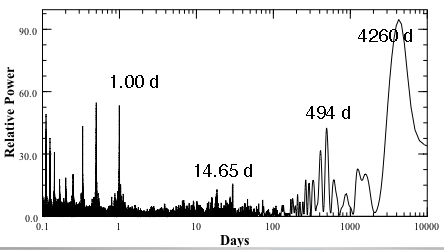
The strongest remaining peak is at 4260 days, corresponding to an 11.7 year orbit (very similar to Jupiter’s 11.8 year orbital period). Keeping the orbits circular, use the “polish” button to produce a Levenberg-Marquardt optimized fit. Zoom in and scroll to show the time interval between 1996 and 2002. The gaps each year when the star is behind the Sun as seen from Earth are easily visible:
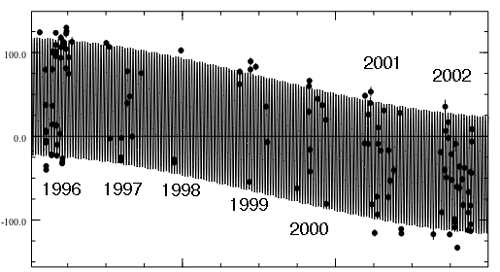
The two planet system does quite a reasonable (but by no means perfect) job of reproducing the observed radial velocities. After the announcement of the first planet at the end of 1996, interest in the star died down to some degree. The number of target stars being observed at Lick was being increased as Debra Fischer stepped in to manage the Lick Survey, and other systems, especially Upsilon Andromedae, were clamoring for telescope time. During the 1998 season, 55 Cancri was observed only twice. By 1999, however, the Upsilon Andromedae system had been sorted out, and renewed attention was focused on 55 Cancri. During 2000 and 2001, it became clear that the system likely contained at least three planets. With the 14.65 and (in my fit) 5812 day planets removed from the radial velocity curve, the residuals periodogram shows a peak at 44.3 days:
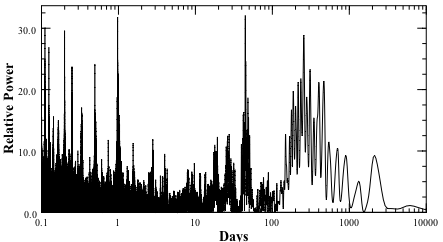
The signal from the 44.3 day planet is not as strong as for the other two planets, but a large number of velocities from 2002 seemed to clinch the case for this third planet:
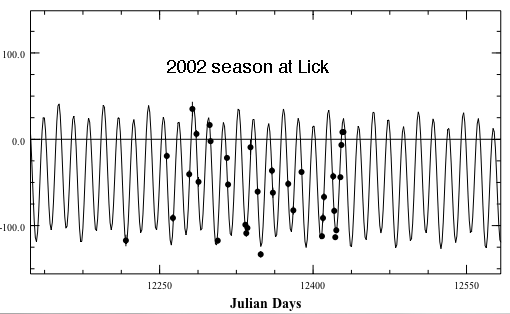
Use the console to optimize the three planet fit using circular Keplerian orbits. When I do this, the chi-square statistic is reduced to 6.4, and the rms scatter is 12.5 m/s. The fit is still not perfect. Either the planets are eccentric, or there are additional planets in the system.

